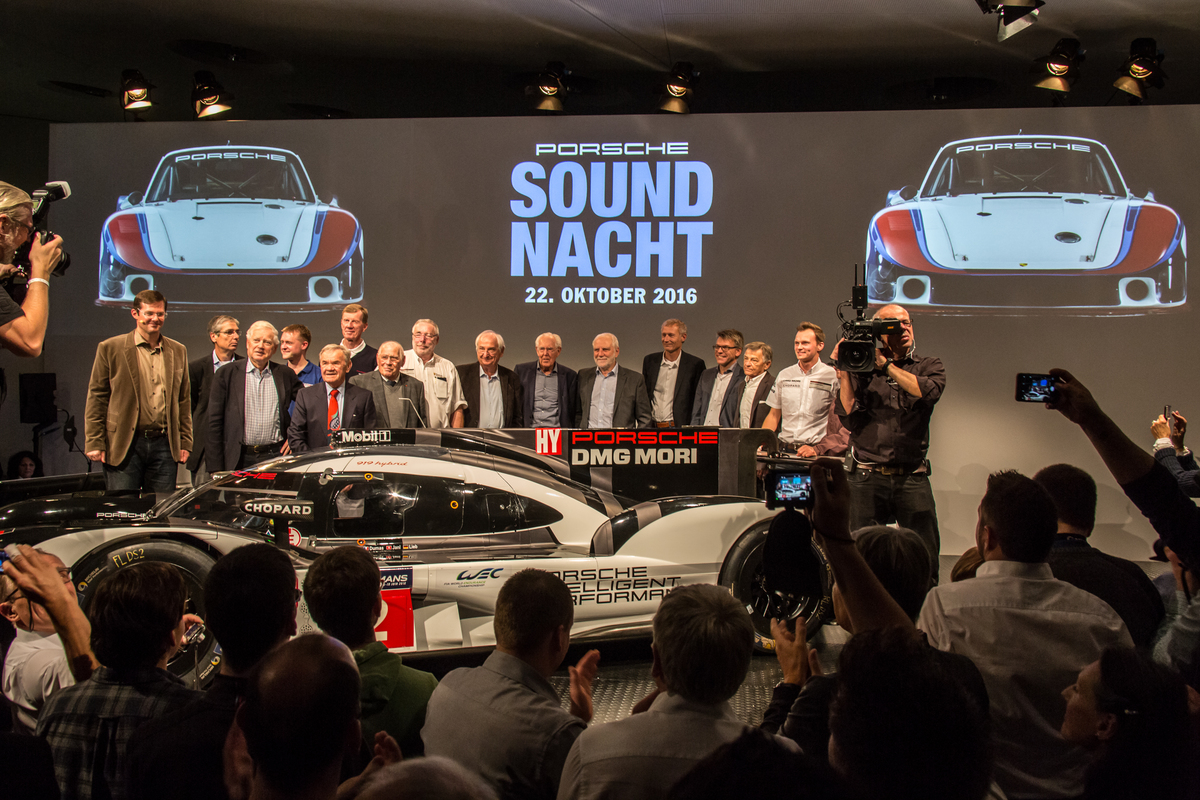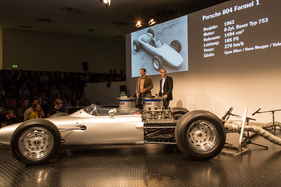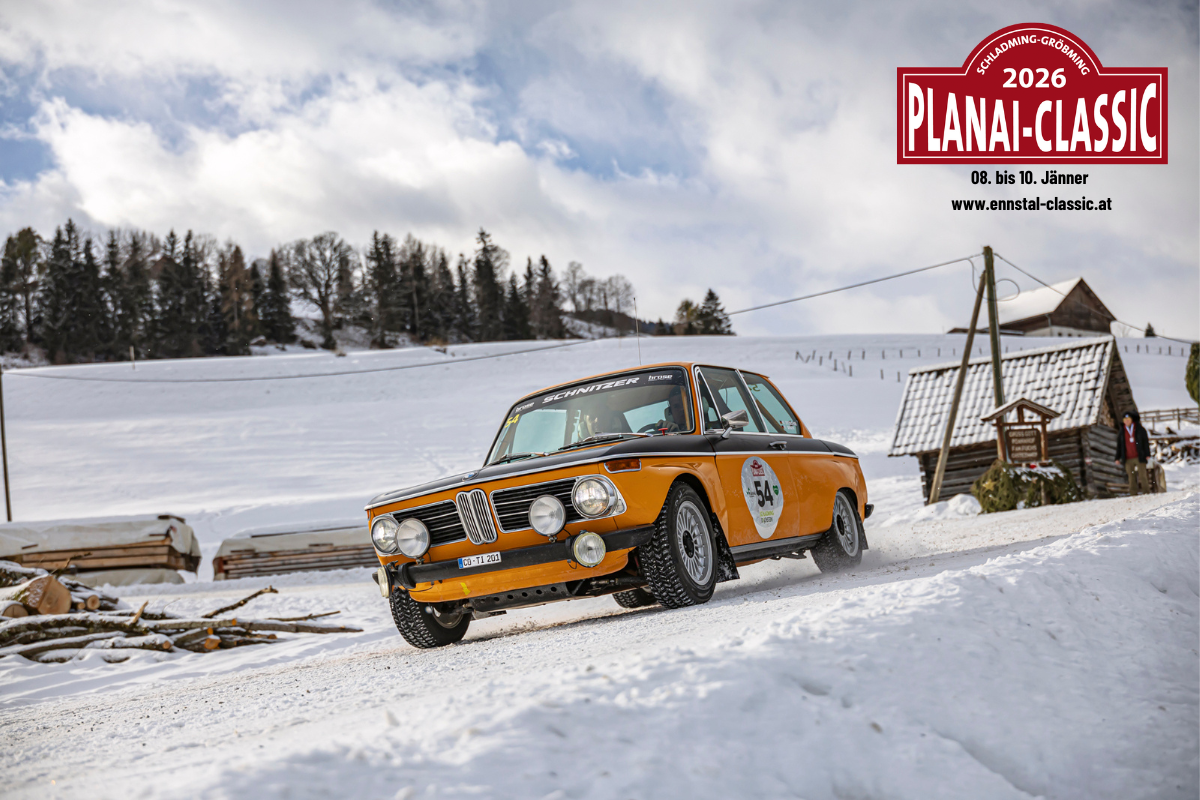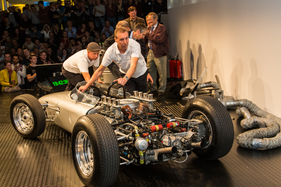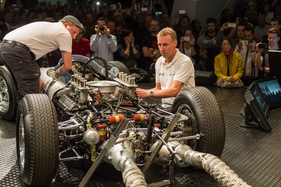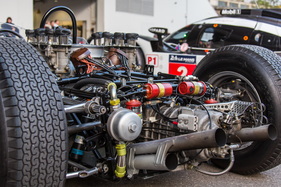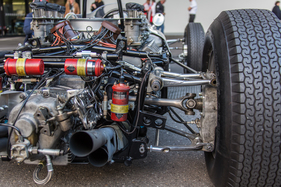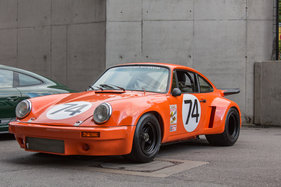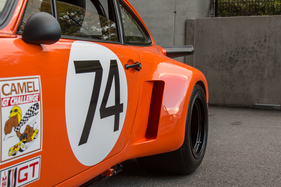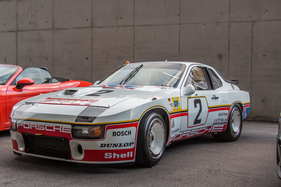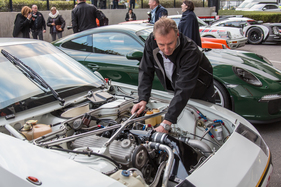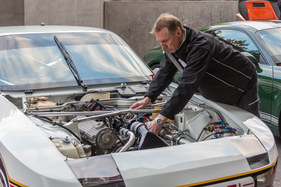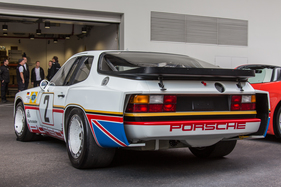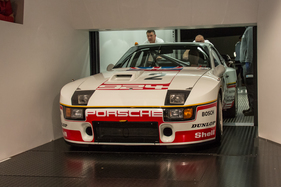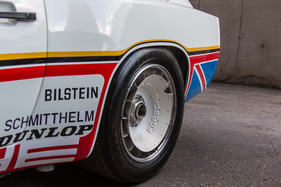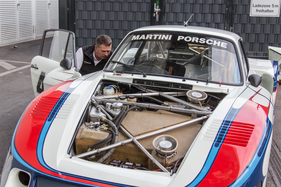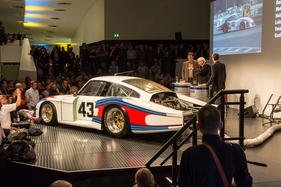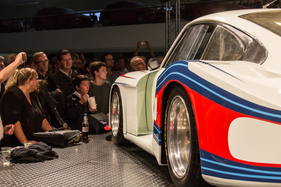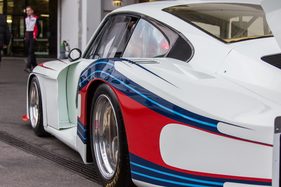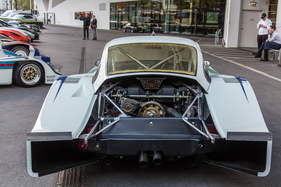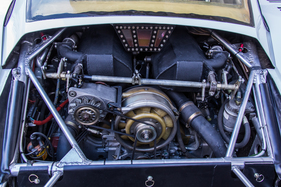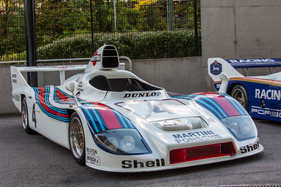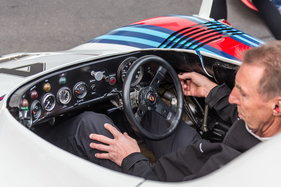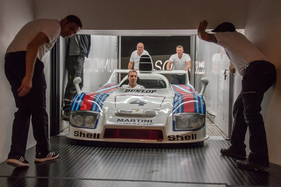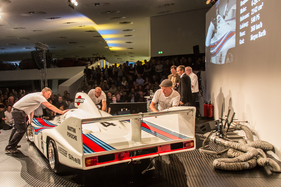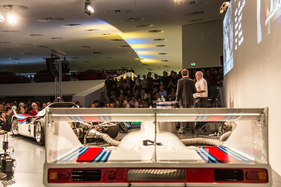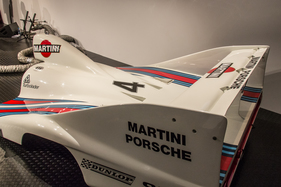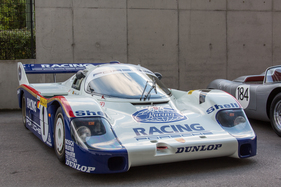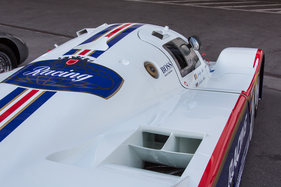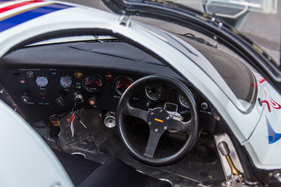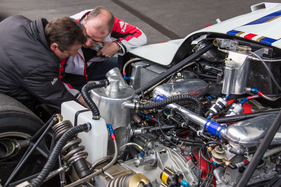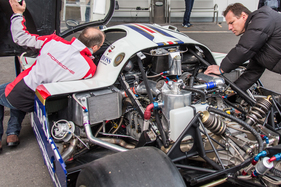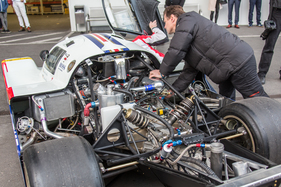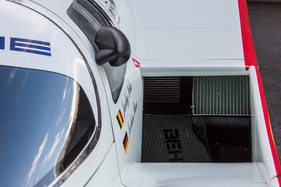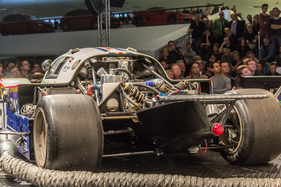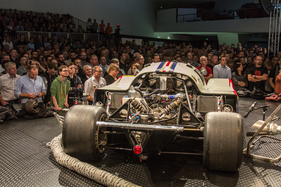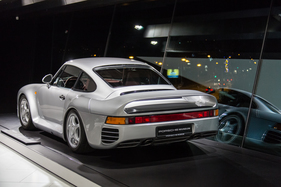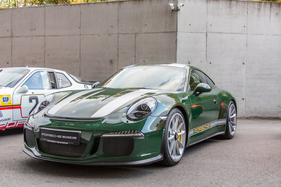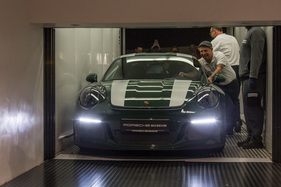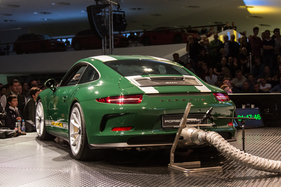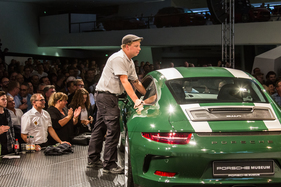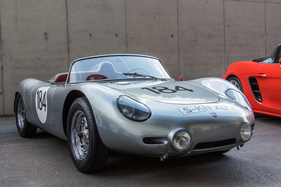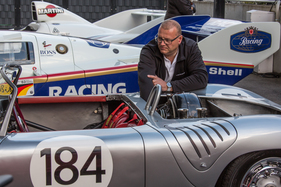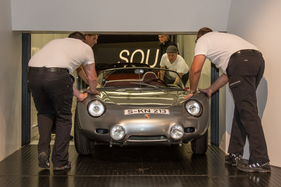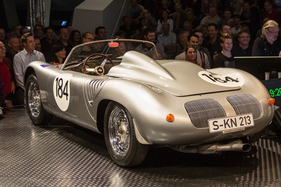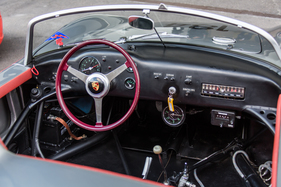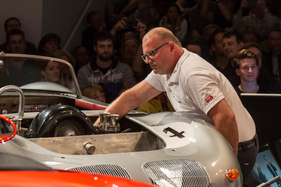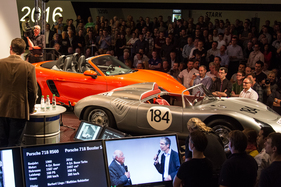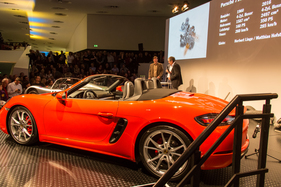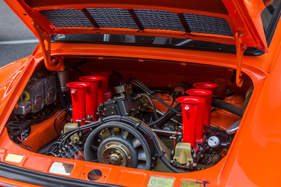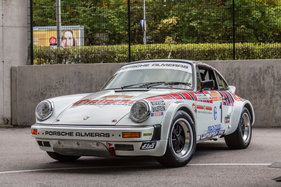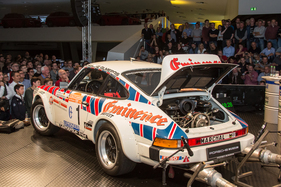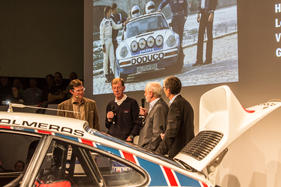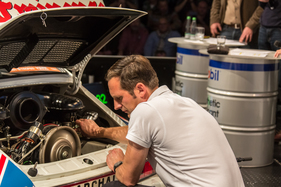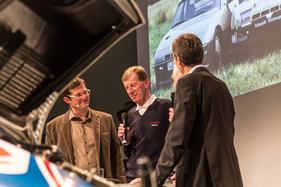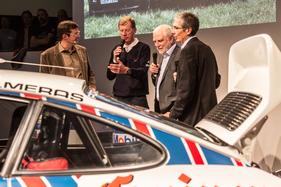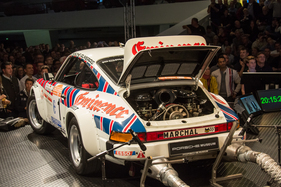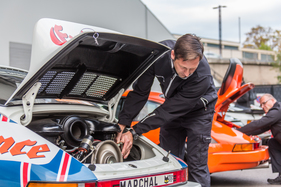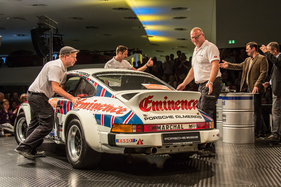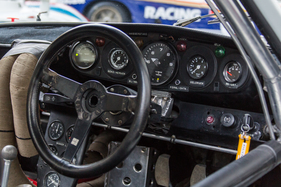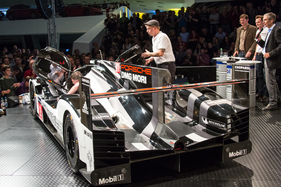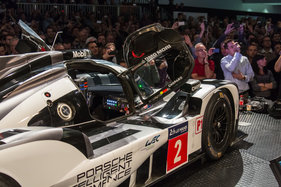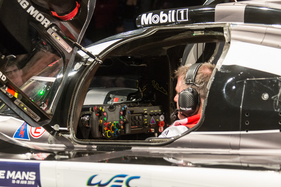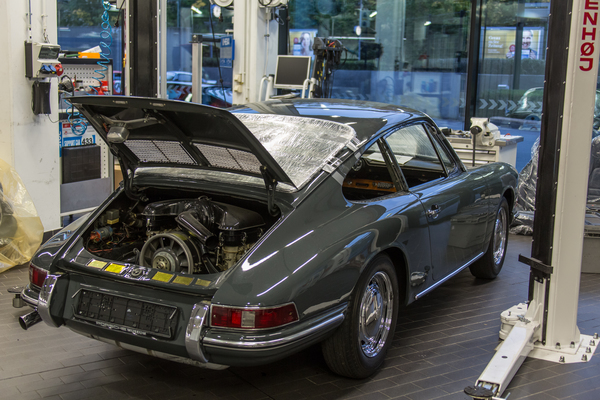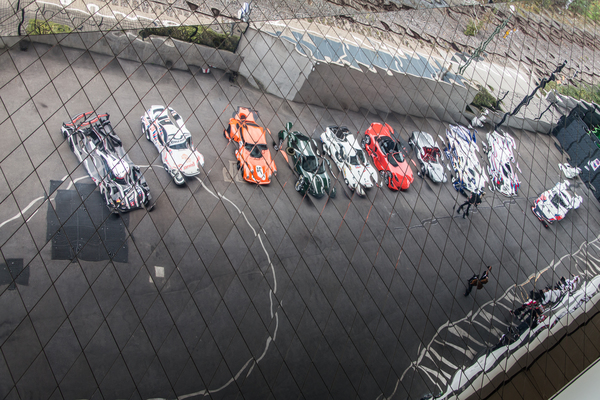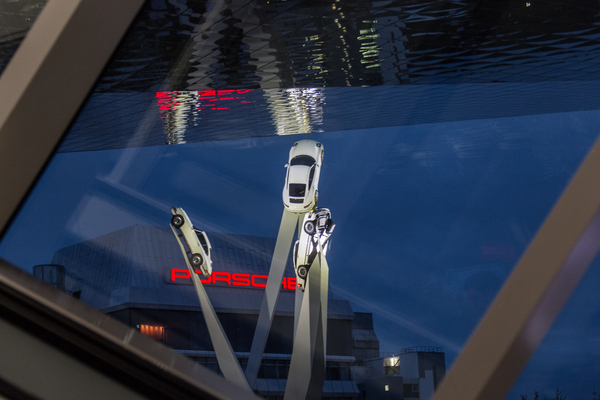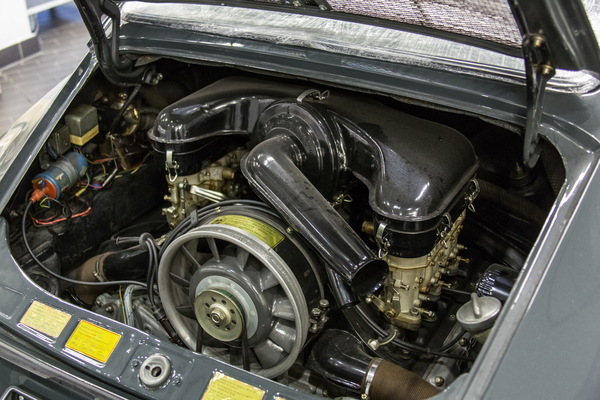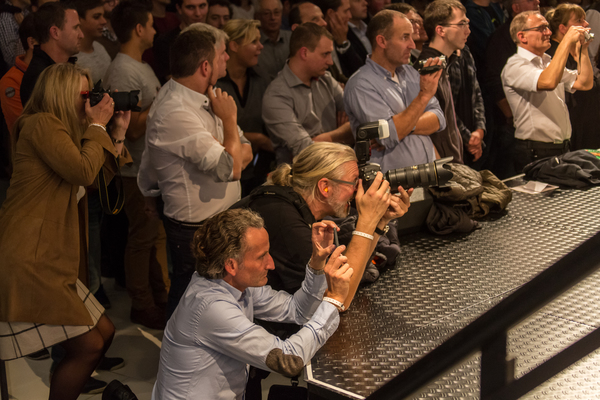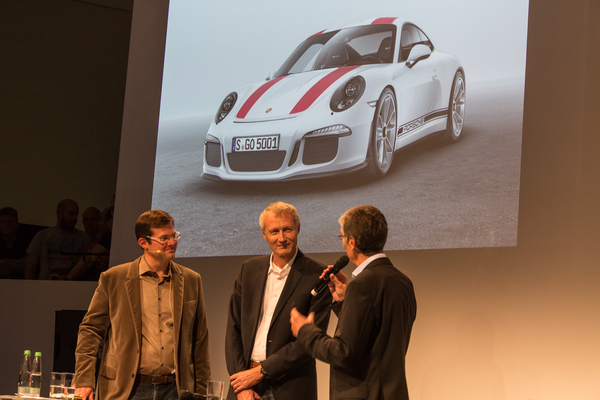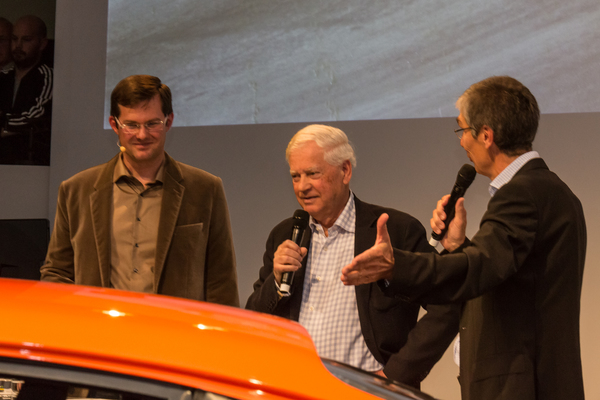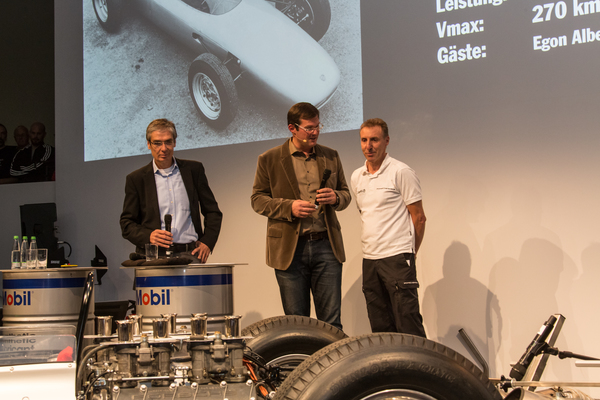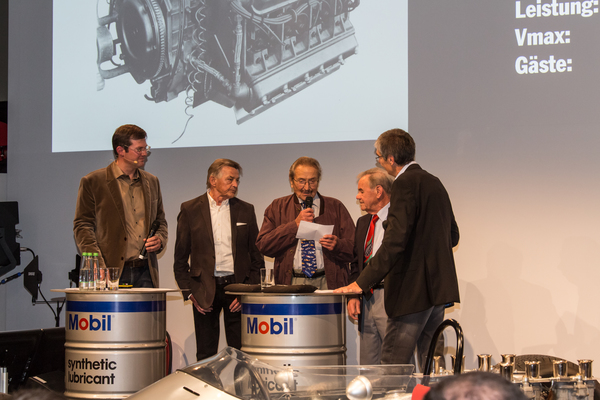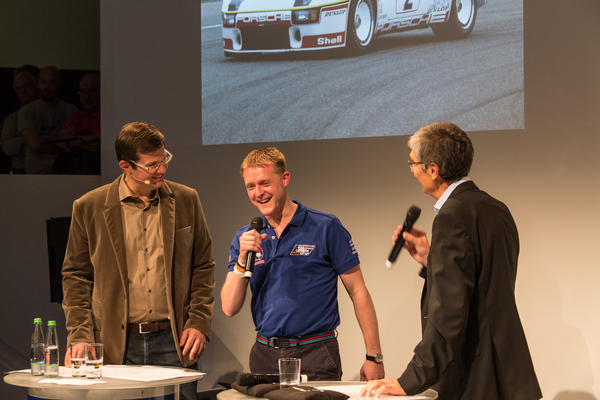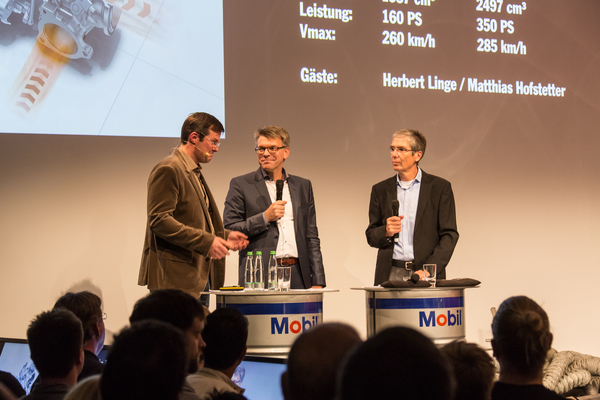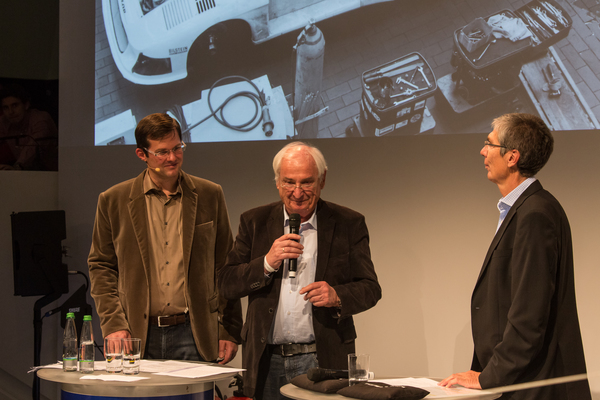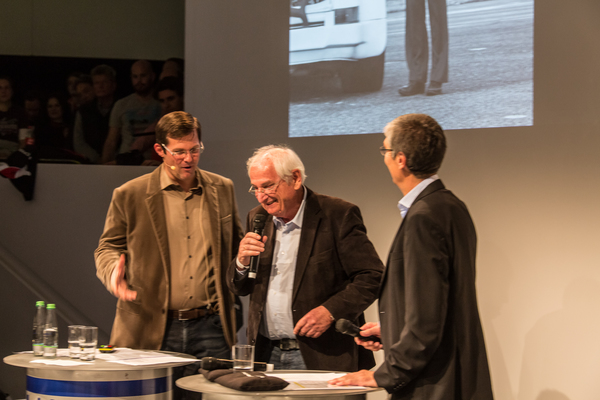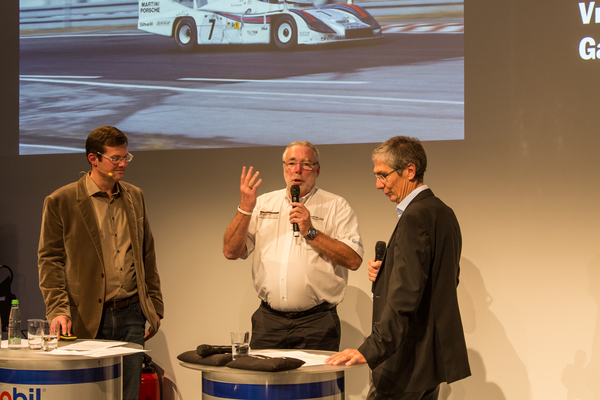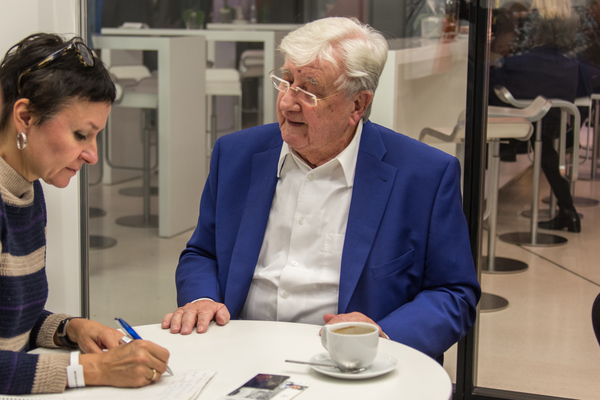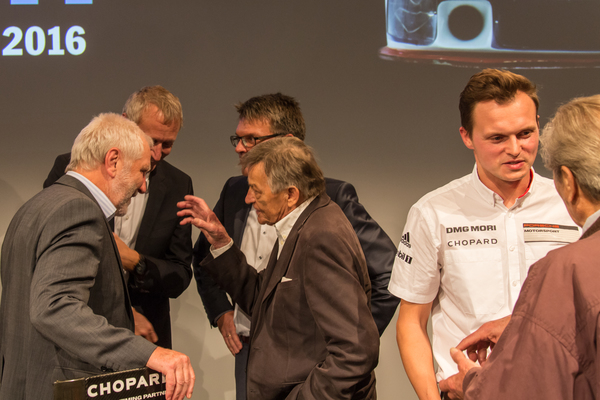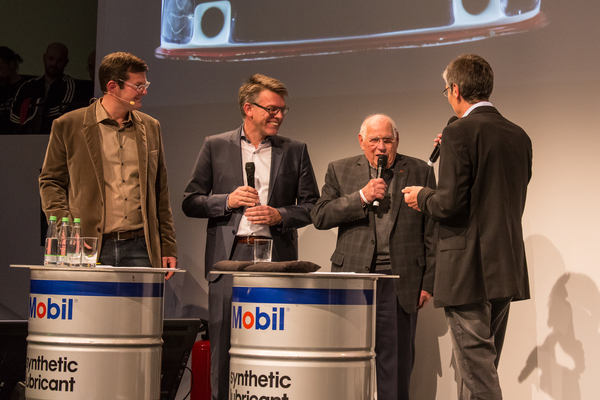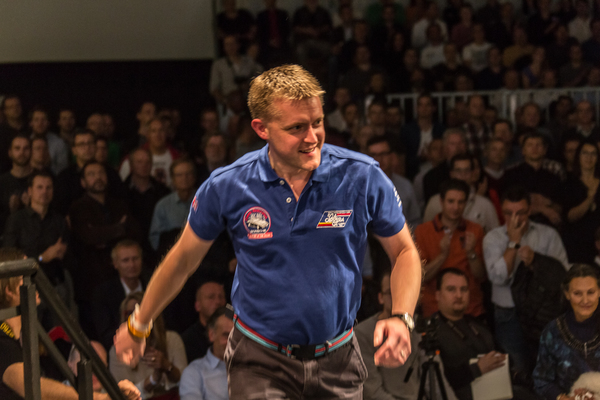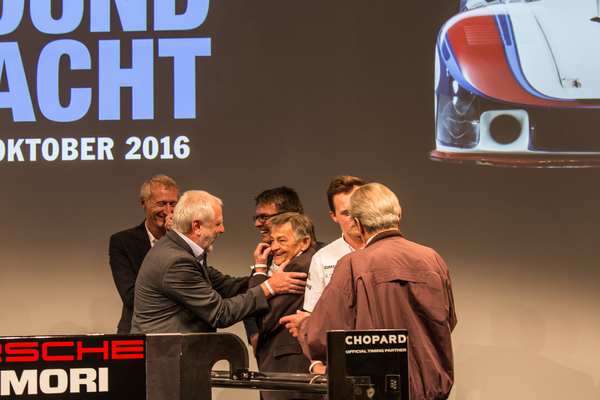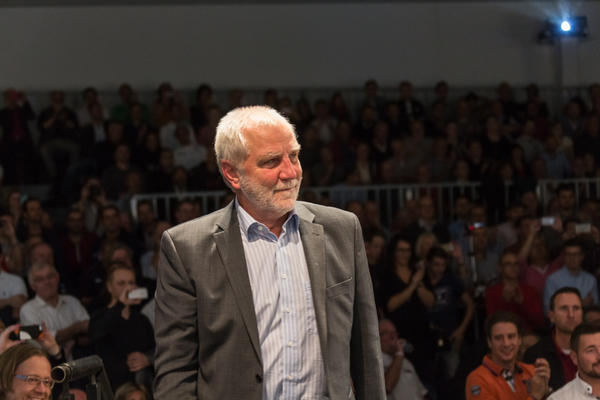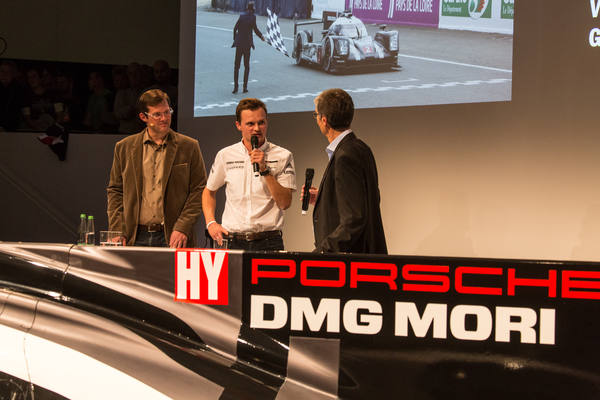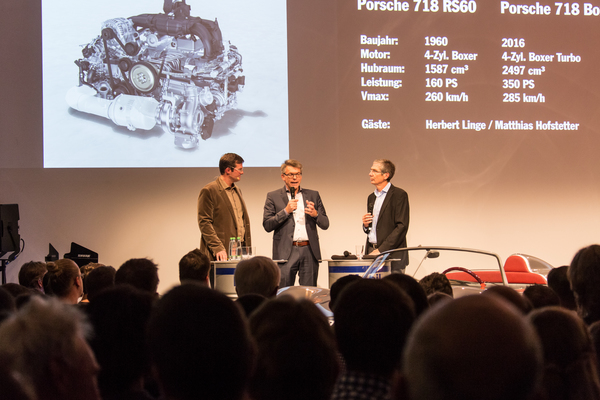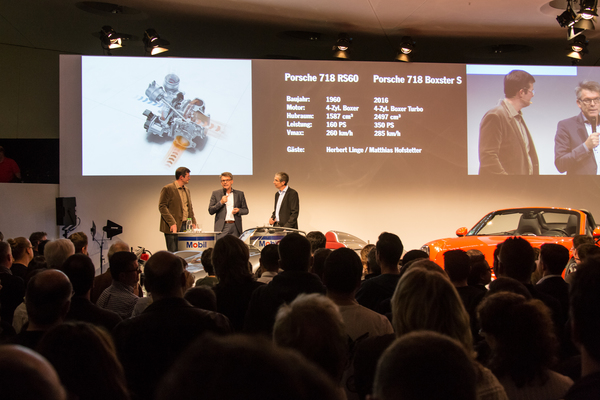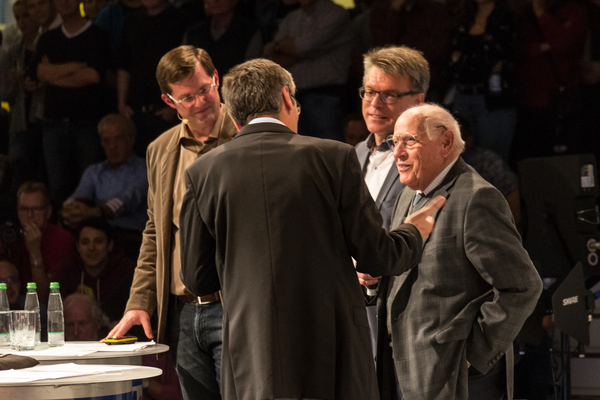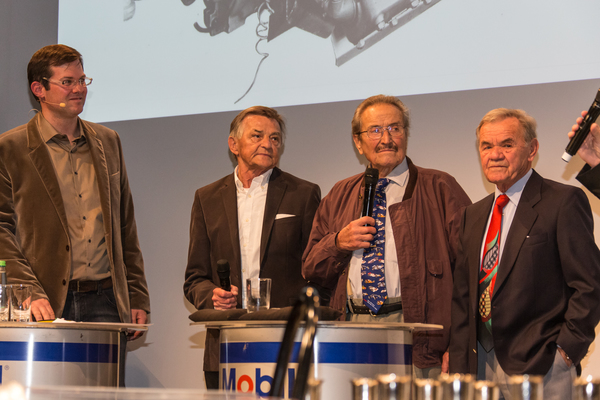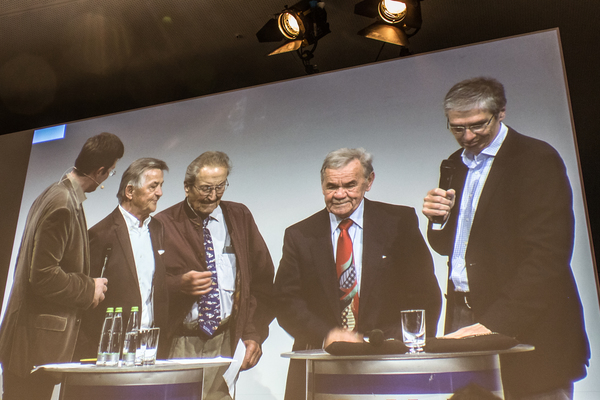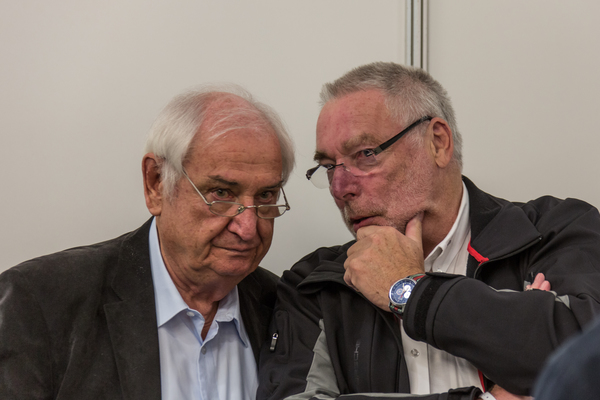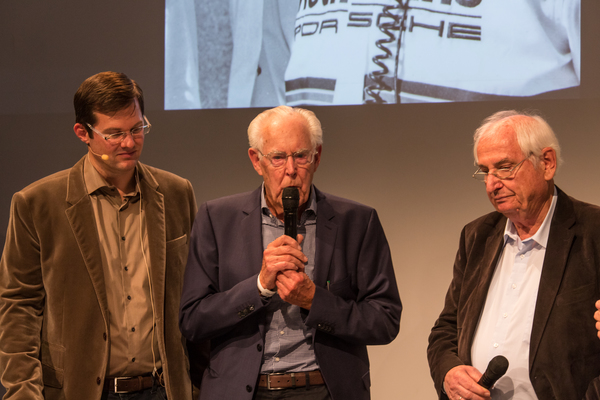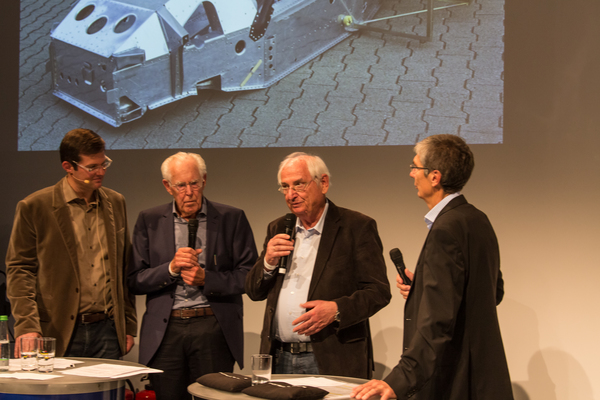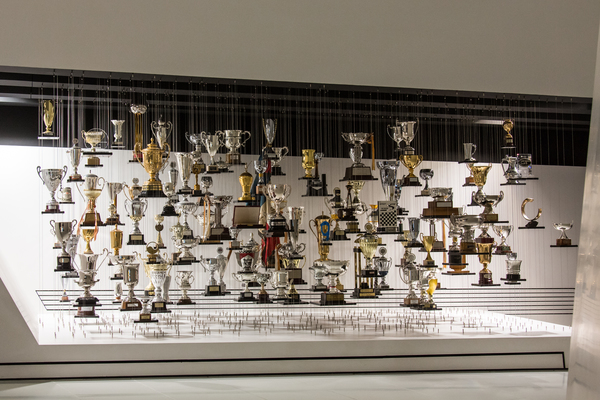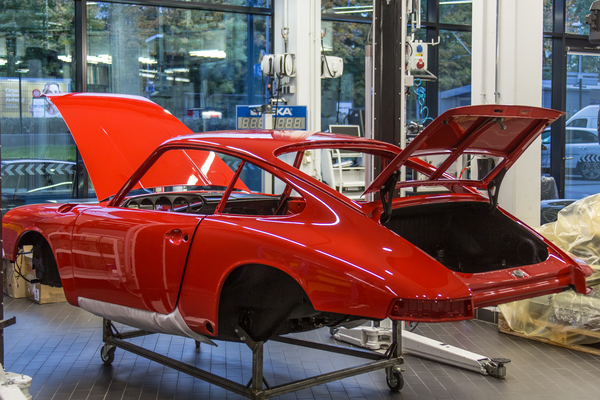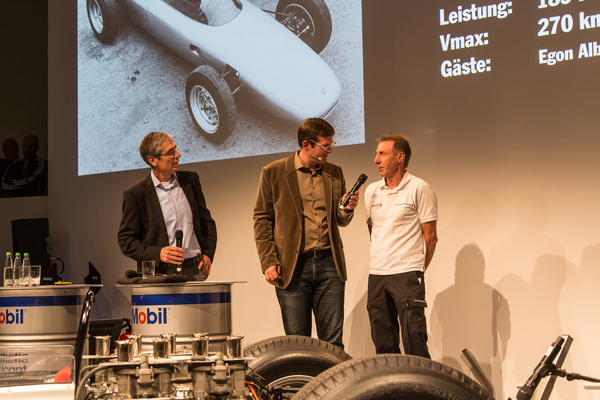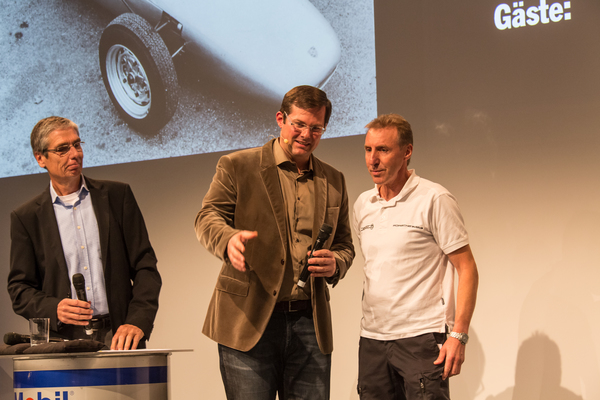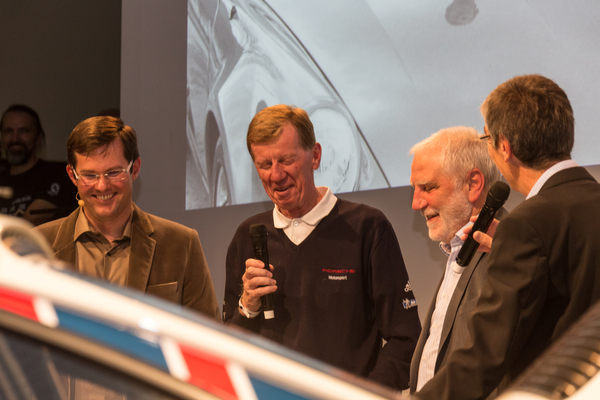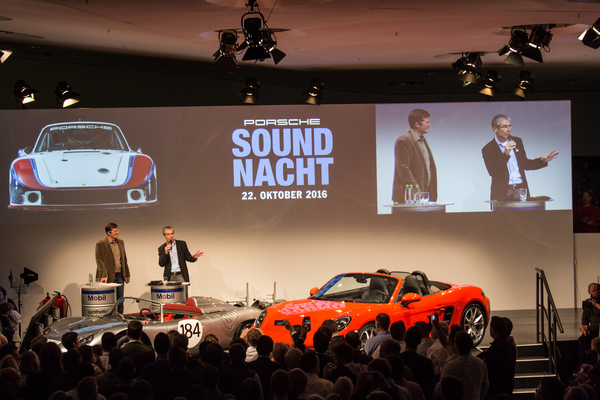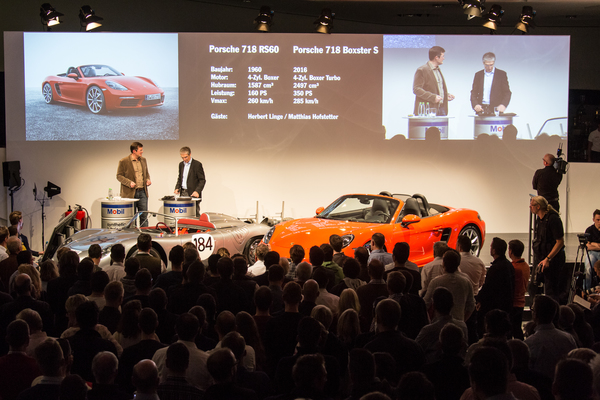The museum director of the Porsche Museum, Achim Stejskal, opened the sixth Sound Night on time, which is getting bigger and more spectacular every year.

Here you can see what Porsche means by a living museum. Le Mans winners, racing legends, technicians and designers were invited, and a well-coordinated team of mechanics prepared the technical side of the event.
Dieter Landenberger, the head of the museum archives, and Walter Zipser, the well-known Austrian motorsport journalist, led through the event with the speed and expertise you would expect from a Porsche.

Two guests from Hamburg who had forgotten their tickets at home, had them photographed by their neighbor and sent to the museum and thus just managed to get in, were greeted with extra applause.
For those who have never been there before, the stories of the invited guests alternated with the sound of the vehicles on stage.
The cars are brought up from the museum workshop in a lift and pushed onto the stage, bringing motorsport to life.
Then and now - Porsche 718 RS 60 Spyder and 718 Boxster
"From Past to Present" was the motto of the event. On stage was a 718 RS 60 Spyder from 1960, the winning car of the "12 Hours of Sebring", back then with Hans Herrmann at the wheel. The winning car of the Targa Florio, powered by a legendary engine with four cylinders and four camshafts.
The topic of 4-cylinders is currently back on the agenda at Porsche, as the "grandson" from 2016, the 718 Boxster S, presented next to it, showed. A beautiful picture when the legends of the day before yesterday and those of tomorrow stand side by side on the stage.
Matthias Hofstetter, the project manager responsible for the powertrain of the current 911 and 718 model series, was the first guest on the podium.
In view of the many six-cylinder fans, it was a courageous decision for Porsche to opt for a four-cylinder. The car was based on a study that caused a sensation at the Detroit motor show almost 25 years ago. The concept is both unique and traditional, a roadster with a mid-engine.
In the fifties and sixties, around 1000 racing successes were achieved with this concept, with the drive making a decisive contribution.
The four-cylinder unit with a displacement of 1.5 liters produced 160 hp and enabled a breathtaking top speed of 260 km/h at a time when people were still driving VW Beetles and BMW Isetta.
The latest descendant of the 718 RS 60 also comes with a four-cylinder boxer engine, albeit of the most modern design. The variants on offer differ in terms of displacement and output, one 2.0 liter with 300 hp and the other 2.5 liter and 350 hp, which follow the current downsizing concept.
Proof that the new Boxster S sounds like a real Porsche was provided immediately, with the acoustic part of the sound night starting with an unexpectedly modern sports car sound.
Porsche legend Herbert Linge, who started out as an apprentice at Porsche, went through all the stages at the company, won Rome-Liège and countless other class victories and became head of the testing department, took a leap back into the past with the 718 RS 60.
The car still inspires Linge today, as it was the further development of the Spyder, with which racing history became a reality at Porsche. "For me, the car was a distinguished Spyder, visually stunning and with an extremely powerful engine."

Winning the world championship in the two-liter class and countless other successes such as European Hillclimb Championships etc. speak for themselves.
You can see what motorsport means to Porsche enthusiasts when the number eight appears twice side by side on their birthday. But that doesn't stop Herbert Linge from speeding his car around the track this year at the centenary of the Targa Florio in Sicily. When asked whether fast cars or charming ladies tend to keep you young, he said "in my case, it was probably the fast cars".
The unique sound, as it was heard on the world's racetracks in the sixties, is still thrilling today, and the applause from the audience was corresponding.
Only for one year - Porsche 804 Formula 1
Porsche only raced in Formula 1 for one year, Egon Alber, Hans Mezger and Valentin Schäffer still remember those days well.

The 804 is the successor to the 718 Formula 2 with which Porsche won the Formula 2 World Championship in 1960. Ferry Porsche then agreed to design a pure Formula 1 racing car. The result was what was technically feasible at the time. A mid-engined racing car with a 1.5 liter eight-cylinder engine with four overhead camshafts. The engine was one of Hans Mezger's masterpieces.
The vehicle was also the first Porsche with internal disc brakes, a fine example of how closely motorsport can go hand in hand with series production.
A year later, these disc brakes were used in the Porsche 356 Carerra 2.
The vehicle on display, chassis number 001, was freshly rebuilt in four months by the mechanic from the museum workshop, Walter Leyer, who was called onto the stage. "Repairing the torsion bar suspension took most of the time," he commented on his work.
This year, the Monoposto was driven by Jacky Ickx at the Monaco Grand Prix Historique.
With engine designer Hans Mezger, head of development Valentin Schäffer and racing mechanic Egon Alber, half the Porsche racing team from 1962 was on stage.
Hans Mezger was not involved in the Formula 1 engine right from the start, so many things were already fixed when he began his work. "It was a big task for me, as I was quite young at the time and didn't have as much experience as later. We were encouraged by the aforementioned four-cylinder engine that won the Formula 2 championship in 1960. The new engine was to be an eight-cylinder engine, which also had to be upgradable. That was a great challenge."
"Formula 1 in 1962 was wonderful," reported Valentin Schäffer, and talked about his experiences. "Once at the Nürburgring - I had previously driven the baby - Huschke von Hanstein came to me and said, the car isn't running properly, take this.
I wasn't the perfect driver, but I knew how to handle the car and at 9000 to 9500 rpm I passed everyone in the car. Von Hahnstein asked what was going on, I revved the car up to 7500. I said: at 7500 rpm, there's nothing going on yet".
Schäfer continued: "The car was built under time pressure, not an easy task for the mechanics, if you only knew what goes on in my head when I see the car for which I still made the parts myself ...
Back then, I had to assemble the first engine and put it on the test bench, and that was a bit of a fiasco at first, the engine didn't run.
My colleagues asked, what have you put together? After everything had been checked, however, it was clear that the problems were not in the assembly, but in the construction, which was problematic.
Unfortunately, the F1 Porsche was only in use for one year. One big victory in France and then the Formula 1 adventure came to an end. Ferry Porsche had simply said "it's too expensive for me" and sponsorship was not as established back then as it is today.
It was a real shame, because on the test bench the car was already producing 133 hp per liter of displacement and had potential for the next year.
Back then, we worked day and night for a year. Screws in the workshop, logistics and test bench runs - all this had to be done. There were 1140 km to drive from Zuffenhausen to Monte Carlo, with three people taking turns, plus brake problems on the towing vehicle. When we finally arrived, the first training session was already over, which was pretty stressful back then, I can tell you that."
"Formula 1," explained Valentin Schäffer, "back then meant four people for two cars. I'd like to know what the guys who drive to Le Mans now think, how we did it back then.
And what would be unthinkable today, the 1.5-liter Formula 1 engine lived on in endurance racing. Ferry Porsche didn't just want to race in Formula 1, so he set the task of ensuring that the engine was also suitable as the basis for a long-distance engine.
The engine was then called the 771, had a displacement of 2 liters and was used until 1968. In the final year, Porsche achieved first, second and third place in the one-make world championship with the engine, in which only the stroke and bore were slightly modified.
A Formula 1 engine that wins endurance races is unthinkable today.
But we should be glad that the Formula 1 involvement was so short, because the capacities freed up were put into the development of the later 911 engine. Hans Mezger gave us the engine for one of the most beautiful sports cars ever.
It was what everyone had been waiting for: historic Formula 1 sound in the Porsche Museum, 185 hp from 1.5 liters of displacement. Fascinating but almost unbearable without earplugs, at least on stage.
The Jägermeister Porsche 911 RSR 3.0
In the color that became legendary in the seventies, the next car came out of the elevator. Eckhard Schimpf, journalist, team boss and enthusiastic racing driver has a very special connection to the car and beamed as "his old friend" was pushed onto the stage. He was able to buy this car in 1974, one of 37 vehicles built in the factory.

Schimpf is one of the founders of the "Jägermeister Racing Team", whose tradition is now being continued by "72STAGPOWER". They were able to buy back the original Carrera he used back then from the USA. The goal of buying up all the Jägermeister cars and bringing them together is a long-standing project. And just as he got his Jägermeister relatives involved in motorsport back then, he has now persuaded them once again to get involved in buying back the racing cars. There are now 15 orange cars together again, a piece of European motorsport history.
This year, the cars were also in action at Schloss Dyck with Striezel Stuck, as the vehicles are not meant to be stationary.
"For me, it was a really exciting car in an environment where super-class people were at the start. I felt a bit small next to Mass, Icks, Stommelen, Wollek and Kausen, but racing with people like that is quite something. There was a great bond between the drivers, they ate together, friendships were formed in racing that no longer exist today.
According to Walter Zisper, there is a saying among journalists: "If you had learned something decent, you wouldn't have to work at weekends".
A circumstance that prevented Eckhard Schimpf from ever being able to drive a complete motorsport season, because as a journalist he was on Sunday duty every 2 to 3 weekends.
After 300 races and a shelf meter of books produced, he says with great enthusiasm before starting the engine: "The car still makes me move today, it's an amazing sound. I feel as if the car smiles at me just by looking at it".
The sound of the 330 boxer horsepower and its volume could not be topped by the applause that followed.
Le Mans winner Porsche 936/77 Spyder
Dieter Landenberger made a small leap into 1977 and went to Le Mans again. An aluminum trellis frame, a 2.1-liter 6-cylinder boxer engine with 520 hp was Porsche's answer to the new sports car world championship in 1976.
The 1977 Le Mans winner, Jürgen Barth, came directly from the Sports Cup in Hockenheim, where he acted as race director. The route Hockenheimring - Porscheplatz in just under an hour is not bad either.
In 1977, he started from fifth place and a defective injection pump threw the team back to one of the last places. The second and third cars failed during the race, so it was decided that Jacky Icks would drive the car. However, he didn't like the set-up at all at first, the car understeered too much. Strangely enough, however, he drove the car faster than his own. At night, the car lost its mirrors, but Barth said "we didn't need them, there was no faster car anyway".
However, the regulations required two rear-view mirrors, so they were glued on. The Renaults dropped out, the Porsche took the lead, but two hours before the end a cylinder burned out. The lead was 45 minutes, but standing in the pits, the Mirage naturally came closer and closer. Barth, as the most technically experienced driver, was then allowed to drive the last 2 laps with the wounded machine shortly before the end of the race - that's another way to win Le Mans. His motto was "as long as the wheels are turning, we're still going".
The car, perfectly set up by Norbert Singer, was perfect. But 48 hours of testing on the Paul Ricard racetrack, together with Roland Kußmaul, always at the limit to see what could break, were not much fun.
The week after the Le Mans victory, Jürgen Barth was sent to Australia to help with the London-Sydney Rally as a mechanic! Those were the days.
The feeling of togetherness within the Porsche team was simply irreplaceable.
Last year, Herbert Linge won a championship for the first time in his life with an RSR, he just can't let it go and after the sound check it was straight back to the Hockenheimring.
The ring on his right hand is "the golden Nürburgring", won with Rolf Stommelen at the Nürburgring in 1981 with the 908/3 Turbo, in which you sat on the front axle. According to Linge, "a genius car that Piech came up with back then".
The rally Porsche 911 SC San Remo
Walter Röhrl also attends the sound night for the first time, accompanied by racing engineer Walter Kussmaul.
"San Remo, beautiful rallies, gravel, dust, pure Italy and incredibly enthusiastic spectators, rally driving was fun," said Zisper at first.
"But the San Remo makes me wistful, because the end wasn't so glorious. That was the bitterest retirement of my entire career, as it was also the only race I was able to drive in 1981. 1981 would have been the first chance to spoil Audi's chances, unfortunately that didn't work out, but in 1982 and 1983 I snatched the world championship from them twice in a row.
I was incredibly enthusiastic about the car, it had 280 hp and went from 1000 to 8000 rpm without a hole. For a non-all-wheel drive car, the Porsche had the advantage of very good traction thanks to the rear engine. That's why we'd worked out that I'd get them wet on the tarmac anyway, maybe we wouldn't lose so much on the gravel and then we'd go back to tarmac at the end, where we'd get it down. That was our plan. At the beginning, it worked out even better than we had calculated," says Röhrl.
Kußmaul: "You also have to add that the car was ordered in Zuffenhausen on July 22nd and went into series production there in terms of bodywork. Then it came out, was finished, i.e. reinforced, then it went back into series production and came to Weissach about 12 days before the start of the rally.
There, Walter drove out the asphalt set-up with Pirelli tires, but there wasn't enough time for the gravel set-up. So I called the mayor in Weissach and asked if we could drive on a gravel track somewhere. He said yes, down there by the forest, after the railroad crossing, there's a path going up the forest on the right, there's nice gravel.
Then I did the gravel set-up and thought to myself, Walter doesn't need to drive it, he's allowed to drive 300 km on the rally beforehand and that's actually enough."
Walter Röhrl: "Yes, and that's how it was, I'd never driven the car on gravel before. The rally started with six asphalt stages and we won them all, but on the gravel we were a bit slower. When the gravel stages were driven twice, I set the best times on the second run, so we were right on target."
Unfortunately, it all came to an end on one of the last gravel stages. The day before, the organizer had reworked the gravel again with a bulldozer and, as with the snowplough, a small mound of earth was created on the side of what was cleared away.
And although the mound of earth could have supported the Porsche a little when drifting at 160 km/h, unfortunately the axle tore off on contact. Bang - that was it.
Kußmaul: "The San Remo is unique in the rally scene. From the Maritime Alps, it goes over to Tuscany with 40% gravel stages and then it's back to the Maritime Alps again. In between, the service team, consisting of two Porsche mechanics and an engine man, had to completely rebuild the chassis in a highway parking lot.
Röhrl: "In contrast to today, the guys had to get under the car in the rain and still work flawlessly, which brought the team together in a completely different way than today. The guys were screwing around, got under the car, but had to be ready again two hours later 150 km away, otherwise I would have arrived at the next special stage with the wrong tires. I'm glad that I was able to experience these times and that I was able to work with people like Roland, it was simply amazing for me."
Following its restoration, the car on display is still used in races, including this year's Roßfeldrennen, where there are bends where you simply have to drive spectacularly for the spectators.
Röhrl: "I always drive effectively, but I know that I have to overcome myself and it was so perfect, from the entrance to the bend to the exit and not even 5 cm to the rock wall, it was really fun". The audience in Berchtesgaden thanked him with a standing ovation on the descent.
Legendary drivers, legendary stories and legendary cars. The latter was allowed to perform its sound, and it left nothing to be desired.
The third generation - Porsche 935/78 "Moby Dick" 1978
With this third generation of the 935, so to speak, it actually started quite harmlessly.
Singer: "When I was at an FIA meeting with Jürgen Barth in Paris in December 1977, the competitors recognized a disadvantage for themselves. They were driving with front engines and the exhaust had to come out in the middle of the vehicle; the system would have been too heavy up to the end of the vehicle. Due to the position of the exhaust, however, they did not achieve the desired ground clearance, and the Porsche with its rear engine was not aware of the problem.
The FIA agreed and corrected the regulations, albeit in a rather vague manner.
"The sill can be modified," it said. That gave me the idea of cutting it off completely and lowering the car by 8 cm. The designer Reite said: "No problem. We had already designed the underbody of the Baby as a tubular construction a year earlier and we'll do the same there".
However, this meant that the transmission was so low that the drive shafts were overstretched in the deflection angle, so the transmission was reversed.
But while you're at it, the full permissible vehicle width should also be utilized. Only 50 mm was missing from the rear axle, so the front axle was also widened to give the whole thing a reasonable balance.
With the original doors, however, this would have resulted in a wasp waist, an aerodynamic disaster. The regulations stated that the original doors had to be retained. So we covered them up, but with a rear air intake for the water cooler.
It was customary at the time for the FIA to approve the car in advance so that there was no dispute in the paddock before the race.
So the gentlemen from the FIA came to us and almost fainted. "Is that still the 911," they asked in bewilderment, "all that's left is the windshield."
After lengthy discussions, they came to the conclusion that the modifications were borderline, but just about compliant with the rules. However, the technical commission in Paris did not agree and banned at least the covered door. But we needed the cooling inlets on the rear fenders, so we found an emergency solution.
We didn't cover the entire door, which was almost as good as the originally planned solution. The protest lodged by Porsche against the decision was upheld shortly before the race, but at such short notice that the car as it stands here was used at the start.
This is the most powerful 911 ever, the first to have a four-valve engine with water-cooled cylinder heads. The intercoolers were also recooled with water, but oil coolers also had to be accommodated, the car was a pure cold store.
Why does the car have two rear windows? The regulations state: "the original rear window must be retained" and we left it in, you can see it."
"How did the competitors react when they were driving prototypes and were suddenly confronted with a 'near-series sports car'?" asked Dieter Landenberger.
"Well, they just had to make way," grinned Norbert Singer. 845 hp from 3.2 liters of displacement, stopped at 366 km/h at Le Mans. The car has long since become a legend.
A four-cylinder at Le Mans - 924 GTP from 1980
With the 924 GTP, we go two years further back in history and stay at Le Mans.
This year, the museum celebrated the 40th anniversary of the Porsche transaxle models with a special exhibition. The Porsche 924 was introduced in 1976, a completely new era for the factory, which produced almost 400,000 units.
To enhance the image of the vehicles, the Porsche 924 was also used in motor racing. In 1980, it even went to Le Mans, one of these vehicles was presented next. The car has a special history and has never been on display in a museum. It was only recently taken out of storage and restored by Porsche Classic in England. Project manager Jonathan Mannell, who was visibly thrilled to be part of Porsche Heritage, represented his Porsche crew from the UK in an extremely personable manner.
The 924 GTP was presented at the Frankfurt Motor Show in 1979. The plan was to enter three cars in Le Mans the following year; the intention was actually to enter only normal cars with works drivers, so nothing wild.
The transaxle cars were very popular in the UK, so they said we would like to have different teams from different countries, including one from the UK, of course.
It is not often that ideas from the island are actually implemented in Zuffenhausen. In this case, it worked out and for the first time since 1970, a Porsche was running with the Union Jack.
The reconstruction took place under difficult circumstances. There was no experience or documentation about the car, there were hardly any records of Norbert Singer, so the restoration was virtually started from scratch. Norbert Singer only had seven months to construct the racing car from the white sheet. After the car arrived in England in November, Jonathan Mannell said to his boys "we're doing the same challenge, the car has to be ready in 7 months".
The finished car was then presented to the press at Silverstone. Derek Bell, Jürgen Barth and other racing drivers were present, a great event.
At the OGP at the Nürburgring, Derek Bell was to lead the transaxle parade with this car, so the car had to be ready by that date.
The work was divided among various Porsche Classic partners. The engine/gearbox, chassis and electrics were restored by different teams, with junior staff also being involved.
In the race, the three 924s finished in 6th, 12th and 13th place. Not too bad when you consider that they were all ahead of drivers such as Dieter Quester and Didier Pironi, who finished fourteenth in a Bavarian car. Striezel Stuck finished 15th, Nick Mason, the drummer from Pink Floyd, came twenty-second in a Lola.
The car has lost none of its aggressive sound to this day, and it is a far cry from the peaceful noise of the production models.
From the parts store back to the race track - Porsche 956
The next car also has an eventful past.
After an accident in 1984 during testing in Weissach, the racing car was cannibalized and sent to museum storage.
It is almost a small miracle how the car stands today, freshly rebuilt by the colleagues from historic motorsport in Weissach, with its legendary chassis number 005, the winner of the 1000 km race on the Nürburgring in 1983.
Race director Peter Falk and vehicle development engineer Norbert Singer were delighted to present the 956 for the first time at the Soundnacht.

In the new Group C regulations, which have been in place for sports cars since 1980, the FIA has prescribed almost everything. Width, height, 100-liter tank, interior dimensions, windscreen and so on. Peter Falk is pleased to say that there was only one thing that wasn't prescribed, and that was the highlight: the engine could be chosen freely. Only the fuel consumption was initially limited to 600 liters for 1000 km, later to 510 liters.
The task was therefore to develop an engine whose consumption was suitable for as many race tracks as possible - a major challenge.
Norbert Singer was to support the whole project by developing a ground-effect underbody. After initial difficulties, with a bit of luck, this was achieved in just three weeks of wind tunnel work.
The first race at Le Mans ended in style, with the cars entering the race with starting numbers 1, 2 and 3 and winning in exactly the same order. With the turbocharged 6-cylinder boxer engine, which produced 620 hp from a displacement of 2.7 liters, Porsche was able to win almost all races in 1983. Customers asked when the car would be available to buy. So the small team had to build 12 more racing cars over the winter, which Jürgen Barth sold within a few days. This meant that there was suddenly fierce competition from within the company's own ranks on the racetracks. The factory's small lead thanks to the further development of the technology did not last long. All the improvements that had proved successful in races were passed on to the private teams three months later. So it was a fair story.
Further developed as the 962, the car was in use until 1994, won Le Mans seven times, became world champion eleven times and achieved a total of over 400 race victories.
Peter Falk sees the secret of the car in the good cooperation between design, testing, the workshop and the drivers. When asked how time-consuming it was to rebuild the car, Norbert Singer said: "The car already looked bad in some places and was completely dismantled. Almost half of the monocoque had to be riveted out and the reworked parts reinstalled. This was a major challenge, and some of the employees who had already worked on the 956 back then were very helpful. It was basically a rebuild of the car. Hannes Wüst and Steffen Münsterer were the men who worked significantly on the construction of the car. Not forgetting Walter Marellia, one of the old hands who helped build the original chassis back then and who made a huge contribution here.
How does the result of all this work sound? Listen to the sound file, it's worth it!
Back to modern times - Porsche 911R
The designation 911R already existed many years ago and so this vehicle also follows the motto of the event "From Past to Present".
Today, 500 hp from four liters of displacement make a top speed of 323 km/h possible. But don't even think about it - the 991 examples of the car have long been sold out.
The head of GT vehicles at Porsche, Andreas Preuninger, explained that the inspiration for the car came from the company's own history. In 1967, there was already a Porsche 911R, a similar car. Similar in the sense that both vehicles are extremely lightweight. However, the story behind the creation of the car is more complicated.
During the development of the 991 GT3, which was launched for the 2013 model year, two variants were built. One with a manual gearbox and one with a dual-clutch transmission.
For the GT3, the decision was made in favor of the PDK because this solution is simply faster on the racetrack. However, the prototype car remained in the underground garage for a long time. It was hidden away again and again so that it would not be scrapped like other prototypes.
The 911R, in its original form, was actually a GT3 with a manual gearbox.
At some point, the rear spoiler was removed and lightweight components were added.
It wasn't until the new aerodynamics of the car were also finished that we said to ourselves, "It's like a 911R used to be - the project was born. The 911 scene received the car enthusiastically. An agile, purist driving machine without any frills hit the nerve of the fan community.
The car was designed for the road, tested in the Zillertal and was simply meant to be fun. Developing a car in 14 months is quite a feat these days.
To hear a naturally aspirated engine delivering its maximum power at 8250 rpm: a fine ear candy for those who appreciate it.
Present and future - Porsche 919
Launched in 1960, the 919 brings us to the present and the future at the same time.
In June of this year, Porsche experienced the most incredible finale of a Le Mans race ever. The leading Toyota retired on the last lap, giving Porsche the victory. A circumstance that gave the event at the Porsche Museum the 919 as the winning car of Le Mans 2016.
Marc Lieb, this year's Le Mans winner, could understand what must have been going on emotionally in the Toyota pits when the leading car suddenly stopped on the last lap. The battle between the cars throughout the night was super exciting. It was unbelievable what happened next, you wouldn't wish that on anyone.
"We had a puncture 10 minutes before the end of the race and were then too far away to win the race. We had already resigned ourselves to finishing a good second. Let's just try again next year, we thought. And then the race took such a turn, a very emotional moment, I've never experienced anything like it before and probably never will again."
The fact that Dr. Wolfgang Porsche wrote a letter of appreciation to the opponent on the race track after the race and the way the winning Porsche also dealt with Toyota after the race shows great sportsmanship and was well received in Japan.
"Toyota even showed up in our tent at the celebration, which was sensational. The whole tent stood up and there were standing ovations for the Toyota drivers and technicians, that was simply a great, brilliant moment."
Porsche knows this situation very well; Hans Herrmann, who was also present, lost Le Mans to Jacky Ixk by 100 meters in 1969, but won the race just one year later. That's simply Le Mans, nothing can be planned there, hence the myth that surrounds the whole race. It's uncanny and that makes it unique.
We only know the car from the outside, inside the car looks more like a spaceship. There is an incredible amount to operate, for example three traction controls, an overall adjustment, a traction control on the rear axle and one on the front axle. If the car is "a bit out of the window", the lap times are immediately four tenths slower.
"The acceleration values and the acceleration profile are simply incredible. When the electric motor is off, you think the car is suddenly braking. It's great fun at Le Mans, flying around the track at 330 km/h," reports the racing driver with a big grin on his face.
The system output of around 1000 hp is distributed between the V4 two-liter petrol engine on the rear axle with around 500 hp and an electric motor on the front axle with 450 hp, the cars are at an extremely high technical level.
"3.5 G pull on you in the Porsche curve, the car weighs 850 kg, the downforce is sensational and it's just brilliant to be able to drive a car like this. Marc Lieb has found his favorite.
The days when Porsche came to Le Mans with four mechanics per car are finally over. This year, almost 90 mechanics and engineers worked directly on two cars and they always had something to do.
In contrast to last year, the winning car was brought to life at the 2016 sound night. Many thanks to Weissach for this.
That was the end of the 2016 Sound Night. In keeping with the motto of the event, we are looking forward to 2017.

